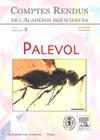Mean body size estimation in large mammals and the computation of biomass in past ecosystems: An application to the Pleistocene sites of Orce and Sierra de Atapuerca (Spain)
IF 1.3
4区 地球科学
Q3 PALEONTOLOGY
引用次数: 9
Abstract
Estimates of adult body mass are usually considered as equivalent of mean population body size in most studies of ancient mammals. However, given that any population is composed in part of subadult individuals, this approach overestimates the mean population body mass and biomass. For this reason, more realistic estimates of mean population body mass should be used. In this paper, we: 1) test five different proxies of population mean mass; and 2) estimate the total prey biomass in the paleoecosystems from the Orce and Atapuerca sites as an approach for estimating their carrying capacity. Our results for past ecosystems support the use of survival profiles derived from the Weibull model (SPW), as they show values in better agreement with those of extant populations. They also estimate higher carrying capacities for the faunal assemblages of Orce than for those of Atapuerca. We suggest that the environmental conditions of Orce could have played an important role in the first peopling of Europe.大型哺乳动物平均体型的估算和过去生态系统生物量的计算:在Orce和Sierra de Atapuerca(西班牙)更新世遗址的应用
在大多数古代哺乳动物的研究中,成人体重的估计值通常被认为相当于平均种群体型。然而,考虑到任何种群都是由部分亚成年个体组成,这种方法高估了种群的平均体重和生物量。出于这个原因,应该使用更现实的平均人口体重估计。在本文中,我们:1)检验五种不同的总体平均质量代理;2)估算Orce和Atapuerca遗址古生态系统的总猎物生物量,作为估算其承载能力的方法。我们对过去生态系统的研究结果支持使用来自威布尔模型(SPW)的生存概况,因为它们显示的值与现存种群的值更一致。他们还估计,与阿塔普尔卡相比,奥勒斯的动物群落的承载能力更高。我们认为,奥尔斯的环境条件可能在第一批欧洲人的生活中发挥了重要作用。
本文章由计算机程序翻译,如有差异,请以英文原文为准。
求助全文
约1分钟内获得全文
求助全文
来源期刊

Comptes Rendus Palevol
地学-古生物学
CiteScore
2.10
自引率
0.00%
发文量
39
审稿时长
17.6 weeks
期刊介绍:
Comptes Rendus Palevol is a fully electronic and peer-reviewed journal, with a continuous publication stream, devoted to palaeontology, prehistory and evolutionary sciences. It publishes original research results, in French or English, in the following domains: systematic and human palaeontology, prehistory, evolutionary biology and macroevolution, and history of sciences. Thematic issues may also be published under the responsibility of a guest editor. All articles published in Comptes Rendus Palevol are compliant with the different nomenclatural codes. A copyright assignment will be signed by the authors before publication.
 求助内容:
求助内容: 应助结果提醒方式:
应助结果提醒方式:


